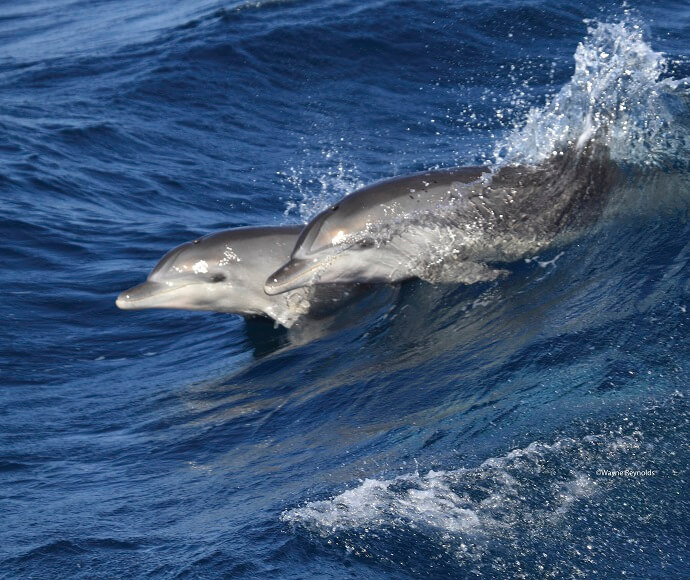What do they look like?
Bottlenose dolphins grow to an average length of 3 to 4.2 metres, and vary in colour, shape and size. They have a short, round snout with a sharp crease between the snout and forehead. Their flippers are long and slender, with pointed tips. Their dorsal fin is usually dark grey, with a prominent curved back. Each dolphin has a different dorsal fin with a unique shape and arrangement of notches and scars by which it can be identified.
What do they sound like?
Bottlenose dolphins have individual signature whistles. As well as whistles, bottlenose dolphins produce clicks, moans, trills, grunts and squeaks. Sounds will vary in volume, wavelength, frequency and pattern. Lower frequency vocalisations are likely used in social communication, whereas higher frequency clicks are primarily used in echolocation.
Where do they live?
The bottlenose dolphin can be found right around the coast of Australia, in temperate and tropical waters. It occupies a diverse range of habitats, including open coasts, sheltered bays and waterways, lagoons, large estuaries and the lower reaches of rivers.
What do they eat?
Because bottlenose dolphins occupy a wide range of habitats, they have access to a variety of sea life. However, they primarily feed on small fish, consuming the occasional squid and crab.
Bottlenose dolphins are a very social species and will often work as a team to maximise their harvest. To hunt larger fish, the bottlenose dolphin will stun the fish by using its tail fluke to throw the fish out of the water and catch the prey in its mouth.
Even though bottlenose dolphins have teeth, they do not chew their food. They will swallow small fish whole, or break up larger fish by shaking them, or rubbing the fish on the ocean floor.
Breeding and life cycle
Bottlenose dolphins can live for up to 50 years. They reach sexual maturity at around 10 years of age and mate all year round.
A female bottlenose dolphin will give birth every 2 to 3 years. After a gestation period of one year, she will give birth to her calf tail-first, to ensure it does not drown. She will quickly push the calf to the surface of the water for its first breath. The calf will suckle for about 6 months and remain with its mother for approximately 4 years. If the calf is female, it will likely stay with the pod it was born into, whereas males will venture out on their own once they are old enough.
Threats
Although bottlenose dolphins are an abundant species, they still experience a number of threats, including:
- boat-strike and disturbance
- entanglement in fishing equipment and beach shark-nets
- degradation of habitat and poor water quality due to pollution
- diseases (such as Morbilivirus and pneumonia)
- overfishing of the dolphins’ habitat.
Interacting with dolphins
Wild dolphins are unpredictable, very strong and have the potential to injure people.
Occasionally, dolphins can become separated from other group members. This can occur for many natural reasons and often leaves the isolated dolphin in a vulnerable situation.
You can be dolphin-friendly and reduce the risk of harm to dolphins and people by following these guidelines:
- Do not approach a dolphin within 30 metres if swimming, or within 50 metres by boat.
- Refrain from touching dolphins or encouraging them to come closer.
- Do not place objects down the blowhole, as this will cause immense harm to the dolphin.
- Do not attempt to hold the dorsal fin and ride the dolphin; this is very stressful to the dolphin.
- Prevent entanglement – reel in your fishing line if a dolphin is near and pull your anchor in slowly if a dolphin is playing with it.
- Do not feed dolphins; it is harmful and illegal.
- Do not encourage a dolphin to play with foreign objects such as balls.
Encouraging dolphins to interact with people could lead to potentially risky behaviours from dolphins. These include:
- nudging, nipping and pushing swimmers in the water
- tail slapping (kerplunking), jaw popping, pectoral slapping, chasing and squawking
- approaching boats at the stern and following boats close to the propeller
- nudging or playing with the engine of a propeller when the vessel is stationary
- approaching kayaks and nudging the stern, keel and paddles
- playing with the anchor chain and rope when the boat is at anchor
- approaching boats and attempting to interact with people on board.
Protection of native animals
All native birds, reptiles, amphibians and mammals, but not including dingoes, are protected in New South Wales by the Biodiversity Conservation Act 2016.

